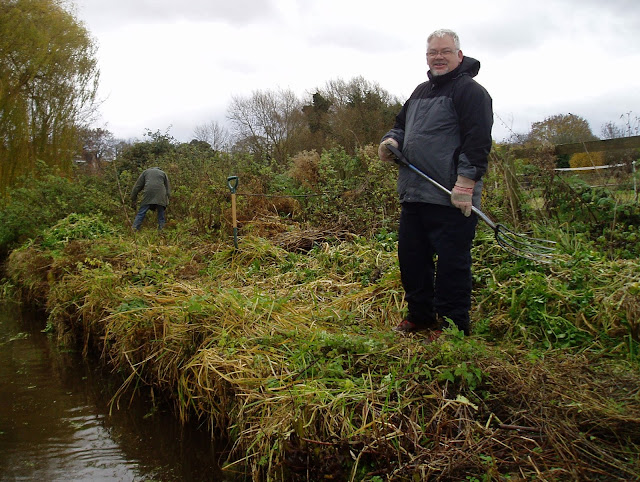By C:
It is nice
to know that one is appreciated. This
was what the local bird population made of our labours last week:
 |
| Outside temperature at dawn: minus 4.3 C |
Some plants which have been hanging on with Green-Gym tenacity ...
may have to
admit the growing season is over?
The airflow over Britain has been from Scandinavia, veering from Russia, but the sun had warmed things up before session-start. The site to which we had been summoned this
week, looks mighty fine at first light.
These shots were taken earlier this month:
 |
| River Thames and the spire of St Peter's Church Wallingford |
 |
| Wallingford Bridge. In the background: remains of Wallingford Castle |
Given its
location – between the town of Wallingford and the increasingly urbanised
village of Crowmarsh – I think Riverside Meadow would count as the kind of
“urban nature” for which NDD-campaigners contend. NDD: Nature Deficit Disorder (not a real medical condition – just a term
used to describe post-industrial-age alienation from the natural environment.)
Shortly after, came one of those wonderfully
surreal passages of Green-Gym conversation, among a group of members of
pensionable years, on the question of which one of them was going to climb back
over the barbed-wire fence to fetch an extra tool:
“… You stay there: it’s easier for me, on account of my junior age.”– “And you’re taller.”– “And you speak French.”
That led in
turn to musings on what ‘Green Gym’ would be in French. [Answer is: La Gym au Vert. – Ed.]
Meanwhile, today’s
task was more ‘green engineering’. ‘More’
in the sense of further engineering works to complete a project, rather than
adapting materials or methods to make the works carried out yet more
eco-friendly. We were aiming to complete
a job started last month (25 October):
installing/topping up the willow bundles on the larger of the two sections of
bank which have in the past suffered from erosion.
First, there
was a trailer to unload:
This proved
a little tricky, as the detachable sides proved reluctant to allow themselves
to be detached. Then the materials,
which had settled during the ride, were reluctant to allow themselves to be
taken off the trailer.
Bundles
which had come undone in the year since they were fashioned, were re-tied. And all were carried for the last leg of
their journey, the short distance to that stretch of the river-bank under
reconstruction. At least one was greeted
with a snatch of song:
 |
| “There’s a bundle coming in!” |
There the willow-packs
were laid parallel to what will be the new shore-line in due course:
Other
Green-Gymmers raked up the remains of the tall-herb vegetation which had been given its
cyclical cut:
The cuttings
were spread over the willow-bundles in situ, to deter those members of the
public who think the wood has been gathered and piled up specially for them to
use as firewood for their bank-side BBQ parties.
All this activity
stoked up an enthusiastic response to the magic words “Tea break!” For weeks, one of our volunteers has been
giving away apples by the boxful. This
week, he had recycled some of the surplus fruit from the apple tree in his
garden:
 |
| Apple cake made according to the recipe in the WGG Cake Book (for which we cannot post a link – sorry! – because the book, which we wrote and self-published, is sold out) |
By session
end, the task had duly been completed.
And not only were we warm from the exercise, but as the last stakes were
being hammered in to secure the bundles from floating away next time the river
rises, the mercury had risen to 4.3 Celsius:















